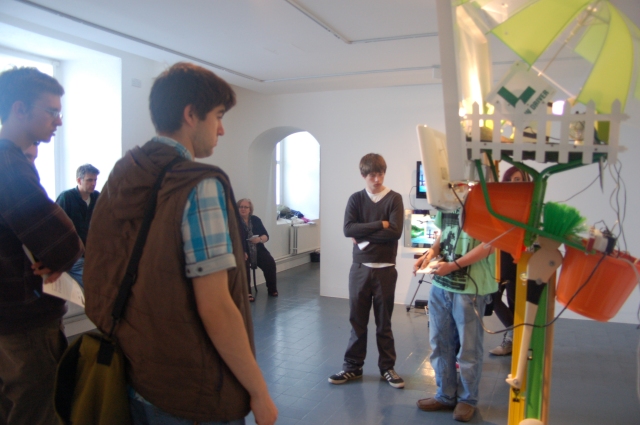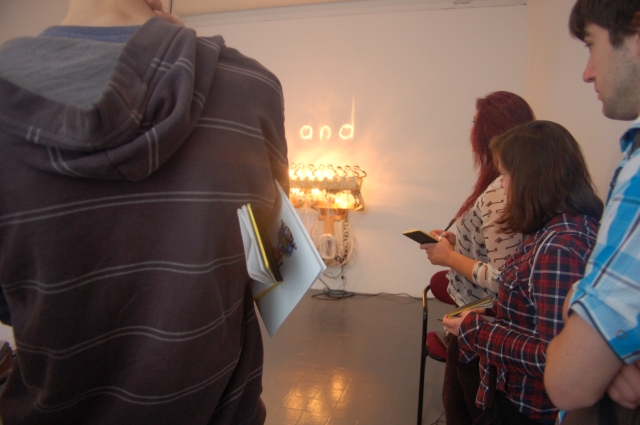Red Square, made up of a group of young people from Kilkenny will be running around Kilkenny Arts Festival 2011 viewing the visual art and theatre strands of the festival; meeting artists and curators, and giving their honest opinions of what the festival has to offer. This week we’ve been getting a behind the scenes look at Visual Art Strand 2. Here’s a sneak peek of focus works from the Butler Gallery’s forthcoming exhibition by Ian Burns – Supreme Fiction (opening tomorrow at 3pm) chosen by some of the Red Square who met with Ian yesterday to talk about his work.
……..
Michael
Ian’s sculptures are of low production cost but of high production quality. The sculpture that caught my eye was Spirit. It is a sculpture that was inspired by the Celtic Tiger constructed from a series of everyday objects, all of which serve a purpose. It’s an extravagantly tall piece that is made up of colours that resembles the tri-colour and is named after the main body of the piece, which is formed of several spirit levels. All of this extravagance is then captured by a single camera witch creates a typical Irish landscape. I believe this piece and all of the pieces in this exhibition will make everyone think a little more about how everyday things can be manipulated into an object that can be so thought provoking.
……..
Suzanne
Supreme Fiction is a collection of assemblages by internationally renowned artist, Ian Burns. In these constructions, the artist combines the basics of everyday found objects with the extravagance of modern technology to produce unexpected landscapes, scenes and cinema. Burns has a fascinating ability to draw these unlikely epic landscapes from household objects and In Glaciers (2008), uses a folding chair, snow shovel and plastic bag to recreate a tiny arctic landscape, captured and presented by small camera, linked to the screen attached to the shovel head. The structural objects of the work provide a narrative to the piece and also reflect the landscape with their cold and clean colour scheme. With very little concealed, the viewer can watch the all-wires-shown workings to find that although it seems that some features of the work are added on to give the piece a more elaborate form, all of the features are functional in creating the effect shown on the screen.
……..
Kym
The piece I chose was made in 2009 in the Irish Museum of Modern Art (IMMA) .The reason I choose this piece of art work is because of it’s glitzy appearance. From the moment I walked into the gallery I noticed this piece. It was located in the corner of the gallery but still managed to catch my attention. As the mirror ball rotates around it briefly reflects an image of a skull on the wall. I thought this was very interesting. The artist named this piece He’s Bad in memory of the late King of Pop , Michael Jackson. The mirror “disco ball” symbolises Michael’s love of dance. This is also one of the many reasons why I am drawn to this piece. I have always loved his music and this piece of art work by Ian Burns reminded me of all the great songs written by Michael Jackson. An amplifier is also used in this piece to pick up the strobes from the motor and the mirror ball. This creates a very cool sound which compliments the piece perfectly. I would definitely recommend this piece of art to the public.
………
Eleanor
Ian Burns’ piece In Increments, is both frustrating and enlightening for me. The exhibit consists of sixteen cheap bulbs rigged to a complicated electrical system (which I don’t understand – I’m no good with engineering) that reflects words through one-dollar mini magnifying glasses onto the darkened wall. As each word appears and vanishes, letter by letter, it’s fun to guess what the next word will be, what secret message the artist is trying to give his audience. But we stand and watch, we start to feel a niggling impatience, because we haven’t gotten our answer yet. We want to know exactly what this piece is, why it was made and what it means. When we don’t get these answers immediately, we start to examine every detail – in what sequence do the letters appear, at what speed, what patterns are forming?
The internet and other parts of 21st century life have helped to shorten our attention spans, but by not giving you all the information at first glance, In Increments forces you to look even more closely at every element that makes the piece, and to ask questions to form your own answers instead of staring passively. It is hard to forget when you leave.’
……..
Mark
I really like In Increments, it’s an unusual piece. A complex arrangement of wires and bulbs which cretes a kind of simple cinematic projection of words onto the wall behind. The words light up one by one – hypnotic, especially with the clickity-click of the switches turning each light on. But the words themselves annoyed me, they didn’t seem to mean much and came across as repetitive and monotonous. They seem like no thought went into what words to project and I wonder was the repetition of the word ‘and’ just a way of filling out the words so they didn’t seem so limited.
…….
Fionn
Making your way through the second room of the Supreme Fiction exhibition, it is difficult not to be caught by the discordant rhythm of a frantically flashing, clicking strobe light. The spectacle turns your attention to the corner of the room, where nestled away, stands a raucous assemblage of light, sound and sculpture. The piece, entitled He’s Bad, was constructed in 2009 by Ian Burns in the wake of the death of Michael Jackson and is, by my reckoning a fitting tribute to the dethroned king of pop. The distorted disco ball that dangles from a gangly wooden structure is constantly in the glare of the somewhat warped strobe light, it’s troubled existence echoing the life of one of our times more troubled gems. This piece, however influenced, looks beyond the death of Jackson and into the realm of loss and loneliness which can so frequently exist beneath a veil of gloss and glamour, and though poignant and sad, it’s unhinged electricity and raw energy seem to shine through.
……..
Hugh
Blank Slate, in keeping with the rest of this exhibition, uses small cameras and objects you’d find in your house to create a “picture” on the mounted television screen. In this case the television screen shows the view from air-force one. The piece being from 2008, the artist explained, is a reflection on the democratic presidential nominations. One of the objects part of the piece is a step ladder, signifying their attempts to climb higher, another component is a child’s black board (the source of the title) representing the childishness of it all. Ian Burn’s work is in the category of those where you say to yourself, “I wouldn’t of thought of that, that’s class!” The nature of his work is quite technological and definitely what you’d call different, so if it’s something different you’re after, you should visit The Butler Gallery.
……..
Leah
My first reaction to Makin’ Tracks was the obvious business of the content. The work made me feel slightly flustered as the sight of the work grabs a large amount of your attention. Although the use of bright, content colours also amuses and entertains. The contrast of bright colour and dark, sharp colour in the work makes a good balance which holds your attention. The work reminds me of electronic appliances in my own household – drawers filled with tangled wires. The piece represents the great impact electronic appliances has on our world today, and in a way it is these electrical appliances that make our world go around, making the world progress and taming the world from not breaking into war or chaos. I like the smaller traits of the work such as the shine on the globe or the pattern in which the wires are hung. The unique shape of the piece is very eye catching and the various different angles in which you can look at this piece triggers different reminders or helps you observe various patterns.









